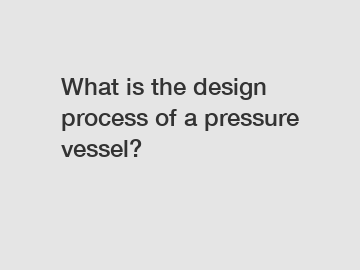What is the design process of a pressure vessel?
Pressure vessels play a crucial role in various industries such as oil and gas, chemical, pharmaceutical, and manufacturing. These vessels are designed to store or transport fluids or gases at different pressures, and ensuring their safety and efficiency is of paramount importance. The design process of a pressure vessel is a complex and intricate one that requires careful planning, analysis, and expertise. In this blog, we will delve into the design process of a pressure vessel and explore the key steps involved in creating a safe and reliable vessel.
The design process of a pressure vessel begins with understanding the requirements and constraints of the project. This involves gathering information on the fluid or gas that will be stored or transported in the vessel, the operating conditions such as temperature and pressure, the material to be used for construction, and any specific regulatory standards that need to be met. It is essential to have a clear understanding of the purpose and function of the vessel in order to design it effectively.
Once the requirements have been established, the next step in the design process is to create a preliminary design concept. This involves sketching out the basic dimensions and layout of the vessel, taking into account factors such as pressure rating, volume capacity, and overall dimensions. The preliminary design serves as a starting point for further analysis and refinement, and provides a basis for evaluating different design options.

With the preliminary design in place, the next step is to perform structural analysis and calculations to ensure the vessel will be able to withstand the internal pressure and external loads it will be subjected to. This involves determining the stress levels in the vessel walls, evaluating the potential for fatigue failure, and assessing the overall structural integrity of the design. Specialized software and simulation tools are often used to perform these analyses, allowing engineers to accurately predict the performance of the vessel under different operating conditions.
In addition to structural analysis, the design process also involves considerations for material selection and fabrication methods. The choice of material for a pressure vessel is critical in determining its strength, corrosion resistance, and overall performance. Common materials used for pressure vessels include carbon steel, stainless steel, and various alloys that offer specific properties for different applications. The fabrication method, whether it be welding, forging, or machining, also plays a key role in the quality and reliability of the final vessel.
Recommended article:Differences Between Workover Rigs and Drilling Rigs
How to Choose the Right Commercial Brewing Tank?
How Does Craft Beer Brewing Process Work?
How to Choose the Best Family Workshop Wheat Flour Milling Plant Vendor?
How to Choose Family Workshop Organic Soap Making Kit Vendor?
Top Used Commercial Brewing Equipment in 2024
Maximize Profits: Buying Used Brewing Equipment Wisely
As the design progresses, engineers must also take into account factors such as thermal expansion, vibration, and fluid dynamics that can affect the performance of the vessel. Thermal expansion, for example, can cause stress and deformation in the vessel walls as temperatures fluctuate, while vibration can lead to fatigue failure over time. By considering these factors during the design process, engineers can optimize the performance and durability of the vessel, ensuring it will meet or exceed the required safety standards.
Once the design has been finalized and all necessary analyses have been conducted, the next step is to create detailed manufacturing drawings and specifications for the vessel. These drawings provide precise instructions for the fabrication team, outlining dimensions, materials, welding procedures, and quality control measures to ensure the vessel is built to the highest standards. Quality assurance and inspection processes are also essential to verify the integrity of the vessel throughout the manufacturing process.
After the vessel has been constructed, it undergoes rigorous testing and inspection to validate its performance and safety. Pressure tests, leak tests, and visual inspections are conducted to ensure the vessel can safely contain the specified pressure without any leaks or defects. Once the vessel has passed all necessary tests and inspections, it can be put into service for its intended application, providing reliable and efficient storage or transportation of fluids or gases.
In conclusion, the design process of a pressure vessel is a complex and meticulous endeavor that requires expertise, experience, and attention to detail. By following a systematic approach that includes thorough analysis, careful material selection, and rigorous testing, engineers can create pressure vessels that are safe, reliable, and efficient. With proper design and engineering practices, pressure vessels can meet the highest standards of quality and performance, ensuring the safety of workers, the environment, and the surrounding community.
Are you interested in learning more about ISO horizontal container intermodal tank, stainless steel cryogenic storage tanks Bulk, Customized Stainless Steel Lng Cryogenic Storage Tank? Contact us today to secure an expert consultation!
Recommended article:Exploring the Benefits of Mark Point Laser Cutter
The Advantages of Incorporating 3D Printing in Your Projects
Key Questions to Ask When Choosing 4U Chassis for Fan Disks ODM Solutions
4U Chassis vs. Fan Disks ODM: Which Enhances Performance?
10 Questions You Should Know about Innovative Techniques in Digital Textile Printing
How Do Advanced Features Transform Heat Pressing?
Maximize Performance: 4U Chassis Can Add Fan Disks Exporter











